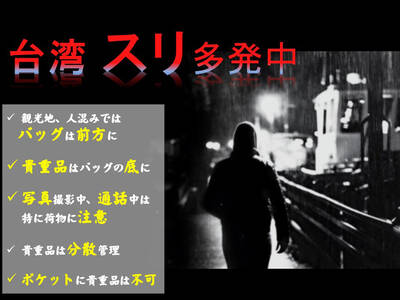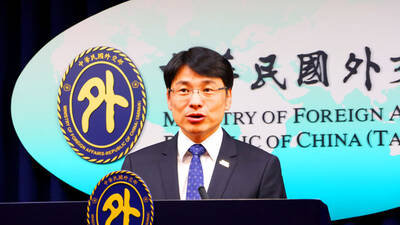An underwater survey near Itu Aba Island (Taiping Island, 太平島) found an outbreak of crown-of-thorns starfish that has killed almost all the coral reefs there, Academia Sinica marine biologist Jeng Ming-shiou (鄭明修) said yesterday.
Jeng, who is also the chairman of Society for Wildlife and Nature, in April led a research team on a diving trip to survey coral reefs in the area, a project commissioned by the Ocean Affairs Council’s National Academy of Marine Research.
To the team’s surprise, more than 90 percent of the corals in waters more than 2m deep were dead, Jeng said, adding that the corals were mostly healthy during their survey in September 2019.

Photo courtesy of the Society for Wildlife and Nature
The team found an unusual outbreak of crown-of-thorns starfish, which prey on corals.
Normally, a 10,000m2 area underwater that is half covered in coral can sustain 20 to 30 crown-of-thorns starfish, he said.
Anything more could kill the corals, he added.
In the April survey, the team documented 532 crown-of-thorns starfish along 14 research routes near Itu Aba, with each route measuring about 500m2, he said.
That translates into 760 starfish per 10,000m2 of water, exceeding the alert level, he said.
Large coral deaths caused by the propagation of crown-of-thorns starfish had also been reported in waters near Australia, Japan, Indonesia and Guam, he said.
To restrict the starfish’s growth, people can protect their natural enemies, such as giant triton snails, and control marine pollution to reduce algae that proliferate over nutrients and become food for starfish, he said.
Removing starfish manually is another option, but the sea creature’s sting is poisonous and can result in painful wounds, he said.
More than a decade ago, a proliferation of crown-of-thorns starfish was also reported in waters near Penghu County, Jeng said.
In 2010, he initiated an action to catch 96 starfish in waters southeast of Penghu’s Siji Islet (西吉嶼), while the Penghu Marine Biology Research Center also led another team to catch 139 starfish in waters around the county, he said.
Another common method is to inject 20cc of diluted acetic acid into starfish, which would die on the seabed, he said, adding that their locations can be identified with the help of image recognition systems.
However, there is no cure-all to curb the growth of crown-of-thorns starfish, so it is vital to continue monitoring coral reefs on a long-term basis and taking swift action against starfish, Jeng said.
More research is needed to determine if the starfish’s proliferation is a general phenomenon or an isolated case near Itu Aba Island, the Ocean Conservation Administration said in a news release later yesterday.
The agency this year started a project to survey the conditions of snails and shellfish crucial to sustaining coral ecosystems, and is working with the National Academy of Marine Research to protect corals.

GENSLER SURVEY: ‘Economic infrastructure is not enough. A city needs to inspire pride, offer moments of joy and foster a sense of belonging,’ the company said Taipei was named the city with the “highest staying power” in the world by US-based design and architecture firm Gensler. The Taiwanese capital earned the top spot among 65 cities across six continents with 64 percent of Taipei respondents in a survey of 33,000 people saying they wanted to stay in the city. Rounding out the top five were Vietnam’s Ho Chi Minh City (61 percent), Singapore (59 percent), Sydney (58 percent) and Berlin (51 percent). Sixth to 10th place went to Monterrey, Mexico; Munich, Germany; Sao Paulo, Brazil; Vancouver; and Seoul. Cities in the US were ranked separately, with Minneapolis first at

The Japan-Taiwan Exchange Association has cautioned Japanese travelers to be vigilant against pickpockets at several popular tourist spots in Taiwan, including Taipei’s night markets, the Yongkang Street area, Zhongshan MRT Station, and Jiufen (九份) in New Taipei City. The advisory, titled “Recent Development of Concerns,” was posted on the association’s Web site under its safety and emergency report section. It urges travelers to keep backpacks fully zipped and carried in front, with valuables placed at the bottom of the bag. Visitors are advised to be especially mindful of their belongings when taking photos or speaking on the phone, avoid storing wallets and

Scoot announced yesterday that starting in October, it would increase flights between Taipei and Japan’s Narita airport and Hokkaido, and between Singapore and Taipei. The low-cost airline, a subsidiary of Singapore Airlines, also said it would launch flights to Chiang Rai in Thailand, Okinawa and Tokyo’s Haneda airport between December and March next year. Flights between Singapore and Chiang Rai would begin on Jan. 1, with five flights per week operated by an Embraer E190-E2 aircraft, Scoot said. Flights between Singapore and Okinawa would begin on Dec. 15, with three flights per week operated by Airbus A320 aircraft, the airline said. Services between Singapore

ENDORSING TAIWAN: Honduran presidential candidate Nasry Afura said that Honduras was ‘100 times better off’ when it was allied with Taipei The Ministry of Foreign Affairs yesterday said it would explore the possibility of restoring diplomatic relations with Honduras based on the principle of maintaining national interests and dignity. The ministry made the remarks in response to reporters’ questions regarding an article titled: “Will Taiwan Regain a Diplomatic Ally?” published in The Diplomat on Saturday. The article said Honduras’ presidential election in November could offer Taiwan the chance to regain an ally, as multiple candidates have promoted re-establishing diplomatic relations with Taiwan. Honduras severed diplomatic ties with Taiwan in March 2023 in favor of Beijing, but since switching its diplomatic recognition,